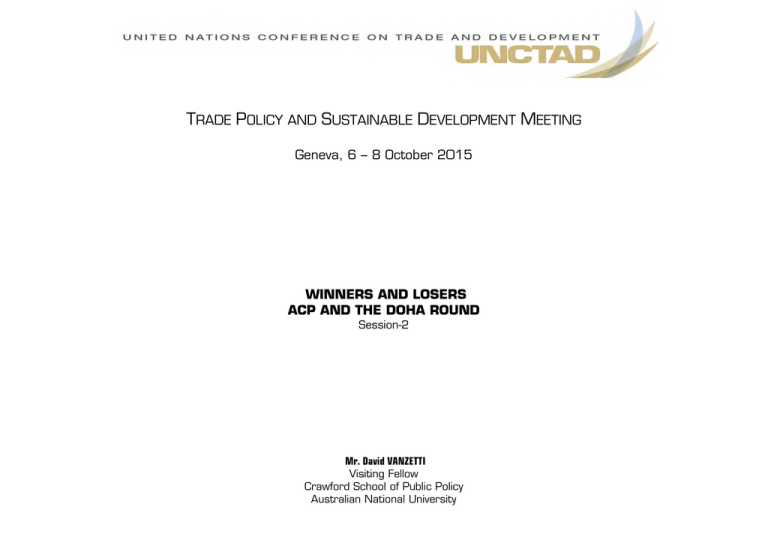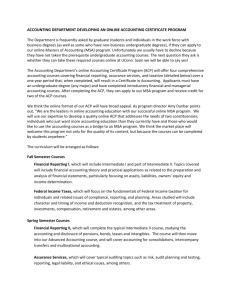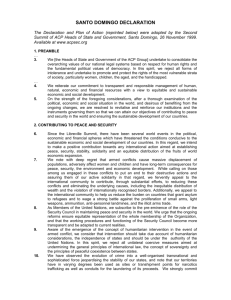T P S D
advertisement

TRADE POLICY AND SUSTAINABLE DEVELOPMENT MEETING Geneva, 6 -- 8 October 2015 WINNERS AND LOSERS ACP AND THE DOHA ROUND Session-2 Mr. David VANZETTI Visiting Fellow Crawford School of Public Policy Australian National University Winners and losers ACP and the Doha Round David Vanzetti Australian National University Trade Policy and Sustainable Development Meeting UNCTAD, Geneva, 6-8th October 2015 Can Doha be revived? • Unresolved since 2008 • Much is agreed • Obstacles remain • Renewed interest, new proposals 2 Trading environment changed • Rising prices • Food security • Domestic support • Public stockholding • RTAs • Emerging markets 3 Look at two proposals • Rev 4 Draft Modalities • Paraguay proposal • average cut 54% with minimum of 20%. • 5% SP with cut of 10% • DVG 36/15%, 12% SP Assess impact on ACP countries 4 Average cut not cut in average • Tariff cuts are unweighted • To get 54% average, cut 42.5% by 100% • Remainder by 20% • Larger cut could be on low tariffs Little better than minimum. Tariff peaks untouched. Request and offer difficult to quantify. 5 Global general equilibrium • • • • • • • GTAP Version 9, base 2011 Bilateral trade and tariffs Includes preferential tariffs (needed for FTAs) from TASTE Whole economy Includes resource (land, labour, capital) constraints Limitation - each country: one region, one household 6 TASTE • • • • • • Aggregates tariffs weighted by bilateral trade Contains bilateral bound and applied tariffs and trade 5052 HS6 commodities x 236 regions 186,835,304 records Aggregate to 30 sectors x 32 regions Generate tariff cuts for GTAP 7 Sectoral coverage Agriculture Industrial Rice Wheat Vegetables, fruit, nuts Sugar Plant fibres Other crops Forestry & fishing Resources Beef and veal Pork and poultry Dairy products Food products nec Services Beverages & tobacco Transport and comm. Textiles Business services Wearing apparel Other services Leather Electronics Petroleum, coal products Motor vehicle & trans equip Wood & paper products Chemical, rubber & plastics Machinery and equipment nec Mineral products nec Manufactures 8 Regions Non-ACP EU_27 USA JPN KOR ODV CHINA IND ASEAN XAS LAM MENA RoW European Union 27 USA Japan Korea Other developed China & HK India Asia Other Asia Latin America Middle East and North Africa Rest of World ACP WA CA EA SA CRB PAC WA West Africa Central Africa East Africa Southern Africa Caribbean Pacific West Africa 9 Bound vs applied West Africa 140 120 100 80 % 60 40 20 0 Rice Wheat Veg, fruit & nut Sugar Plant fibres Other crops Beef & veal Applied Source: GTAP v9 Pork & poultry Dairy products Food products nec Bev. & tobacco Bound 10 Bound vs applied Central Africa • 80 70 60 50 % 40 30 20 10 0 Rice Wheat Veg, fruit & nut Sugar Plant fibres Applied Other crops Beef & veal Pork & poultry Dairy products Food products nec Bev. & tobacco Bound 11 Bound vs applied East Africa 120 • 100 80 % 60 40 20 0 Rice Wheat Veg, fruit & nut Sugar Plant fibres Applied Other crops Beef & veal Pork & poultry Dairy products Food products nec Bev. & tobacco Bound 12 Bound vs applied Southern Africa 120 • 100 80 % 60 40 20 0 Rice Wheat Veg, fruit & nut Sugar Plant fibres Applied Other crops Beef & veal Pork & poultry Dairy products Food products nec Bev. & tobacco Bound 13 Bound vs applied Caribbean 90 • 80 70 60 50 % 40 30 20 10 0 Rice Wheat Veg, fruit & nut Sugar Plant fibres Applied Other crops Beef & veal Pork & poultry Dairy products Food products nec Bev. & tobacco Bound 14 Bound vs applied Pacific 70 • 60 50 40 % 30 20 10 0 Rice Wheat Veg, fruit & nut Sugar Plant fibres Other cropsBeef & veal Applied Pork & poultry Dairy products Food products nec Bev. & tobacco Bound 15 Tariffs facing ACP ag exports 2008 2011 2014 % % % Bound 55.4 65.2 32.2 MFN 13.3 13.9 10.1 9.7 8.7 4.0 • Preferential Source: WTO IDB via WITS. 16 ACP applied tariffs under alternative proposals 16 14 12 10 % 8 6 4 2 0 Source: Calculations with TASTE. Base Rev. 4 Paraguay Applied tariffs facing ACP 18 16 14 12 10 % 8 6 4 2 0 Source: Calculations with TASTE. Base Rev. 4 Paraguay Applied tariffs facing ACP exports to EU Preference erosion. 8 7 6 5 %4 3 2 1 0 Source: Calculations with TASTE. Base Rev. 4 Paraguay Welfare impacts 600 500 400 300 200 $m 100 0 -100 -200 -300 -400 Source: GTAP simulations. Rev 4 PF Implications for ACP • • • • • • • • Preference erosion a problem Rising prices of temperate product imports Less ambitious outcome would suit Not much difference between Rev. 4 and PF But PF not harmonising, not transparent NAMA also important. Less ambitious favours ACP Export subsidies not significant for ACP ACP favoured by loose interpretation of domestic support rules. • ACP should support Doha not RTAs. 21 Limitations • Would tariff cuts be implemented as modelled here? • NTBs, AD ignored • Ignore R&O approach • Aggregation into six ACP groups from 77. • Static not dynamic. 22 The End 23







